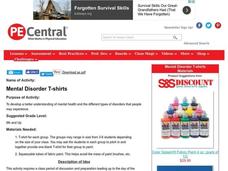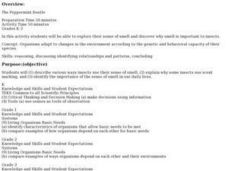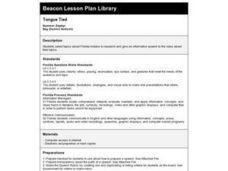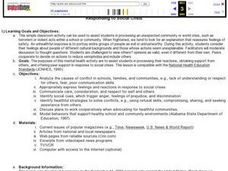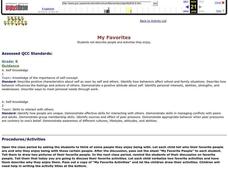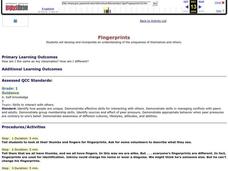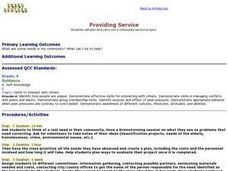Curated OER
Healthy Eating
Third graders discuss healthy eating choices. They explore the components of a balanced diet and the importance of a balanced diet to growth and wellness. Students discuss the types of nutrients in fruits and vegetables that are...
Curated OER
The Five Food Groups
Third graders explore the five food groups. They discuss the importance of the five food groups in their diets. Students research each of the five food groups using a WebQuest. They use the information from the WebQuest to make healthy...
Curated OER
P.E. Bees
Students learn daily positive social living skills and manners using 2 large bee pictures and 36 or so small bees with diferent sayings on them.
Curated OER
Mental Disorder T-shirts
Students develop a better understanding of mental health and the different types of disorders that people may experience. They create T-shirts that explain and display their learning about a specific disorder.
Curated OER
The Peppermint Beetle
Students describe various ways insects use their sense of smell, and examine why some insects use scent marking. They conduct a scent hunt, searching for a particular scent on the trees on school grounds.
Curated OER
Diabetes
Students use maps, phone books and newspapers to determine how much health information and health services exist within their home, school and community regarding Type 2 Diabetes. Students review the available information.
Curated OER
Tongue Tied
Fourth graders select topics about Florida Indians to research and give an informative speech to the class about their topics. The main focus' of this activity are the research, and the speech that each student gives to the class.
Curated OER
Animals Abound Pre/Post Assessment
Learners prepare for or evaluate their experiences in learning about animal persistence. This is part of a multi-segmented unit on animal living, adaptation, and survival.
Curated OER
Responding to Social Crisis
Students, through discussion, identify ways to cope with and process unexpected community or world crisis, such as terrorism or violent acts within a school or community.
Curated OER
Real Attractive
Sixth graders create a collage of attractive people. They write about what makes these people attractive. They discuss what makes someone attractive. They research eating disorders and how the media impacts what people deem as attractive.
Curated OER
Pawing Around
Students identify common wildlife by investigating their footprints. They examine where and how to look for signs of animal activity. They create casts of animal tracks and gather information about the animal from the location it was found.
Curated OER
How Did We Arrive at the Printed Book?
Seventh graders, in cooperative learning groups, research the development of book printing. After examining a story written on a scroll, an accordion book, and a printed copy, they evaluate them according to a certain criteria and...
Curated OER
If We Knew Then What We Know Now -- Cuban Missile Crisis (Background)
High schoolers examine the background of the Cuban Missile Crisis. Using the foreign policy decision-making process, they simulate and elaborate the processe involved. They identify the causes of the misconceptions that plagued the...
Curated OER
Introduction to a Unit on the 1930's Depression in America
Students view and discuss photographic images of the Dust Bowl by Dorothea Lange. They discuss who Dorothea Lange was and why she took the pictures, the conservational factors that contributed to the Dust Bowl and migrant workers and the...
Curated OER
Thanksgiving
First graders examine the reasons for the Thanksgiving celebration in the United States. They research information about what type of items were used in the past and items that are currently used. They investigate life on the Mayflower...
Curated OER
Nutrition and the Food Pyramid
First graders examine the food pyramid and how healthy food effects the body. They discuss what they ate for breakfast and identify what makes a food healthy. Students analyze the food pyramid, and cut out magazine pictures of food and...
Curated OER
Germs
Third graders dicsuss germ. They discuss how they can't see them (germs), but they're everywhere! Students are asked if germs cause disease? They discuss some types of illnesses they get from germs. Students discuss ways inwhich...
Curated OER
Germs
First graders discuss as a class how many of them have sneezed today. They then listen as the teacher explains that germs come out of their nose during a sneeze or when they blow their nose. They then discuss other ways that a person...
Curated OER
Graphs
Students create "snowballs" from crumbled pieces of white paper. They then glue their snowball to the appropriate side of the graph to indicate who has and who has not thrown a snowball. The teacher and the calss then will count how many...
Curated OER
The Mysterious Tadpole
Second graders examine books written by Steven Kellogg, looking for similarities in his illustrations. They also look at images found on the Internet. They listen to a read aloud of The Mysterious Tadpole up to the point where the eggs...
Curated OER
Dinosaur Designs
Second graders examine facts that can be found in nonfiction books. They listen to a read aloud of Patrick's Dinosaur, with time before the end for student predictions. They make dinosaur t-shirts using facts from the book.
Other popular searches
- Behavior Management Plans
- Behavior Management Charts
- Behavior Management Systems
- Behavior Management Lessons
- Classroom Behavior Management



